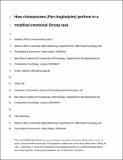Files in this item
How chimpanzees (Pan troglodytes) perform in a modified emotional Stroop task
Item metadata
| dc.contributor.author | Allritz, Matthias | |
| dc.contributor.author | Call, Josep | |
| dc.contributor.author | Borkenau, Peter | |
| dc.date.accessioned | 2016-11-28T00:33:32Z | |
| dc.date.available | 2016-11-28T00:33:32Z | |
| dc.date.issued | 2016-05 | |
| dc.identifier | 240325641 | |
| dc.identifier | 33a98ba6-e9fc-4be9-8279-cc60bf507b75 | |
| dc.identifier | 84948650801 | |
| dc.identifier | 000373743900001 | |
| dc.identifier.citation | Allritz , M , Call , J & Borkenau , P 2016 , ' How chimpanzees ( Pan troglodytes ) perform in a modified emotional Stroop task ' , Animal Cognition , vol. 19 , no. 3 , pp. 435-449 . https://doi.org/10.1007/s10071-015-0944-3 | en |
| dc.identifier.issn | 1435-9448 | |
| dc.identifier.other | ORCID: /0000-0002-8597-8336/work/37477847 | |
| dc.identifier.uri | https://hdl.handle.net/10023/9883 | |
| dc.description.abstract | The emotional Stroop task is an experimental paradigm developed to study the relationship between emotion and cognition. Human participants required to identify the color of words typically respond more slowly to negative than to neutral words (emotional Stroop effect). Here we investigated whether chimpanzees (Pan troglodytes) would show a comparable effect. Using a touch screen, eight chimpanzees were trained to choose between two simultaneously presented stimuli based on color (two identical images with differently colored frames). In Experiment 1, the images within the color frames were shapes that were either of the same color as the surrounding frame or of the alternative color. Subjects made fewer errors and responded faster when shapes were of the same color as the frame surrounding them than when they were not, evidencing that embedded images affected target selection. Experiment 2, a modified version of the emotional Stroop task, presented subjects with four different categories of novel images: three categories of pictures of humans (veterinarian, caretaker, and stranger), and control stimuli showing a white square. Because visits by the veterinarian that include anaesthetization can be stressful for subjects, we expected impaired performance in trials presenting images of the veterinarian. For the first session, we found correct responses to be indeed slower in trials of this category. This effect was more pronounced for subjects whose last anaesthetization experience was more recent, indicating that emotional valence caused the slowdown. We propose our modified emotional Stroop task as a simple method to explore which emotional stimuli affect cognitive performance in nonhuman primates. | |
| dc.format.extent | 15 | |
| dc.format.extent | 713084 | |
| dc.language.iso | eng | |
| dc.relation.ispartof | Animal Cognition | en |
| dc.subject | Attentional bias | en |
| dc.subject | Chimpanzee | en |
| dc.subject | Cognitive bias | en |
| dc.subject | Emotional Stroop | en |
| dc.subject | Great apes | en |
| dc.subject | RC0321 Neuroscience. Biological psychiatry. Neuropsychiatry | en |
| dc.subject | BF Psychology | en |
| dc.subject | QL Zoology | en |
| dc.subject | Ecology, Evolution, Behavior and Systematics | en |
| dc.subject | Experimental and Cognitive Psychology | en |
| dc.subject | NDAS | en |
| dc.subject.lcc | RC0321 | en |
| dc.subject.lcc | BF | en |
| dc.subject.lcc | QL | en |
| dc.title | How chimpanzees (Pan troglodytes) perform in a modified emotional Stroop task | en |
| dc.type | Journal article | en |
| dc.contributor.institution | University of St Andrews. School of Psychology and Neuroscience | en |
| dc.contributor.institution | University of St Andrews. Centre for Social Learning & Cognitive Evolution | en |
| dc.identifier.doi | 10.1007/s10071-015-0944-3 | |
| dc.description.status | Peer reviewed | en |
| dc.date.embargoedUntil | 2016-11-27 |
This item appears in the following Collection(s)
Items in the St Andrews Research Repository are protected by copyright, with all rights reserved, unless otherwise indicated.

